Abstract
During single pass indicator studies across the lungs [14C]urea remains in the vascular compartment, but its molecular size and solubility suggest it might escape abnormally permeable vessels. To test the hypothesis that [14C]urea might be used to distinguish pulmonary edema due to acutely increased intravascular pressure from that due to vascular damage by alloxan, we studied [51Cr]erythrocytes (r), [125I]albumin (a), [14C]urea (u), and tritiated water as dilution indicators in the pulmonary circulation of anesthetized dogs. In addition, the adequacy of albumin as an intravascular indicator was evaluated.
Indicator curves, blood gases, hematocrit, and vascular pressures were determined during a base-line period and repeated 30 and 60 min after treatment in five groups of dogs: (a) saline control. (b) alloxan edema. (c) epinephrine infusion, (d) volume overload, and (e) left atrial (LA) balloon obstruction.
Groups b, d, and e developed a similar degree of edema judging by wet/dry lung weights and histology. Groups a and c did not develop edema. In alloxan edema, differences between the mean transit time volume of u and r (Vv-r) increased over base line at 30 (P < 0.001) and 60 min (P < 0.02); the differences between the mean transit time volume of a and r (Ve-r) increased slightly at 30 (P < 0.03) and 60 min (P < 0.02); and Vu-r significantly exceeded Va-r at 30 (mean difference = 9 ml, P < 0.02) and 60 min (mean difference = 11, P < 0.04). In none of the other groups did Vu-r significantly exceed Va-r. Thus, comparison of Vu-r with Va-r may permit distinction between “high pressure” and “increased permeability” pulmonary edema.
Albumin was not a consistently reliable indicator of intravascular volume as compared with composite red cell and albumin curve.
Full text
PDF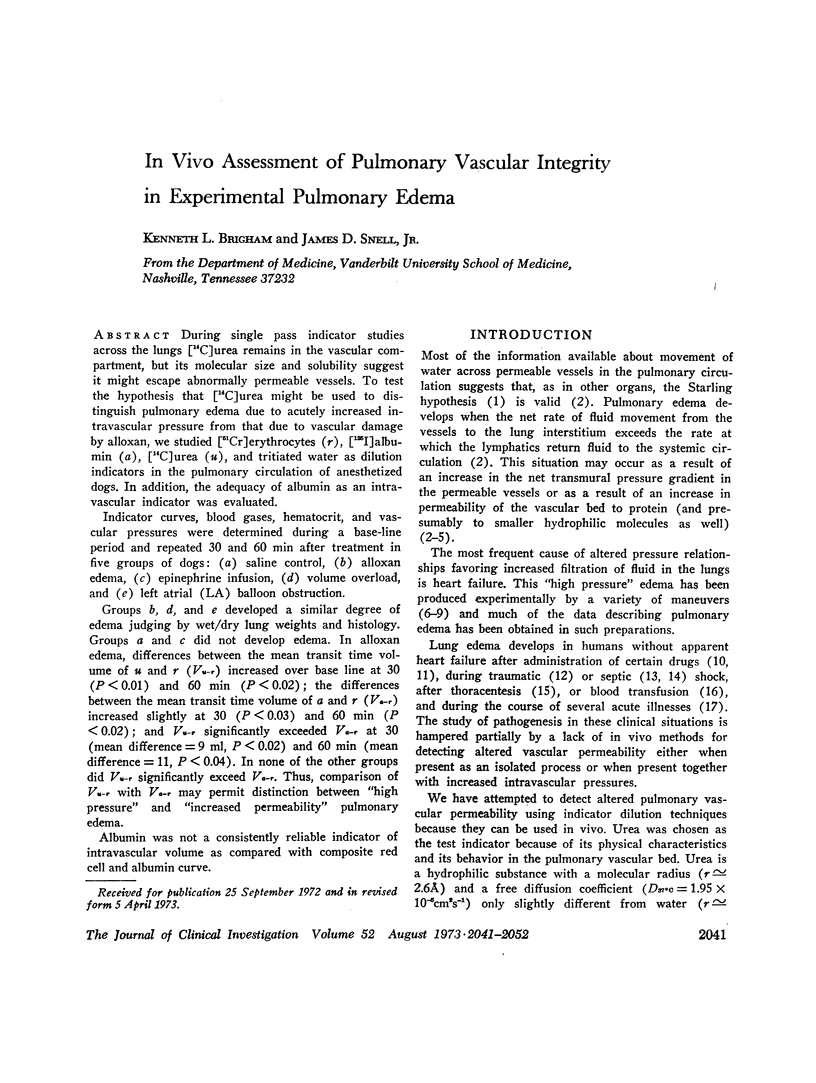
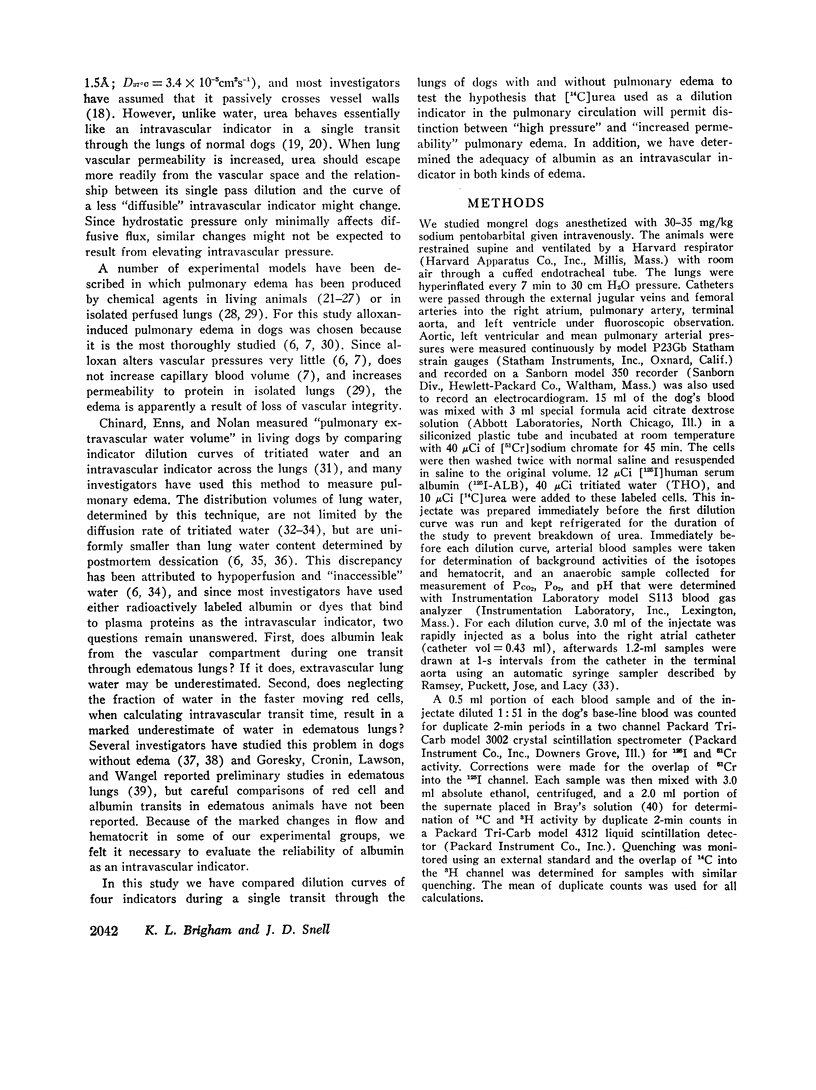
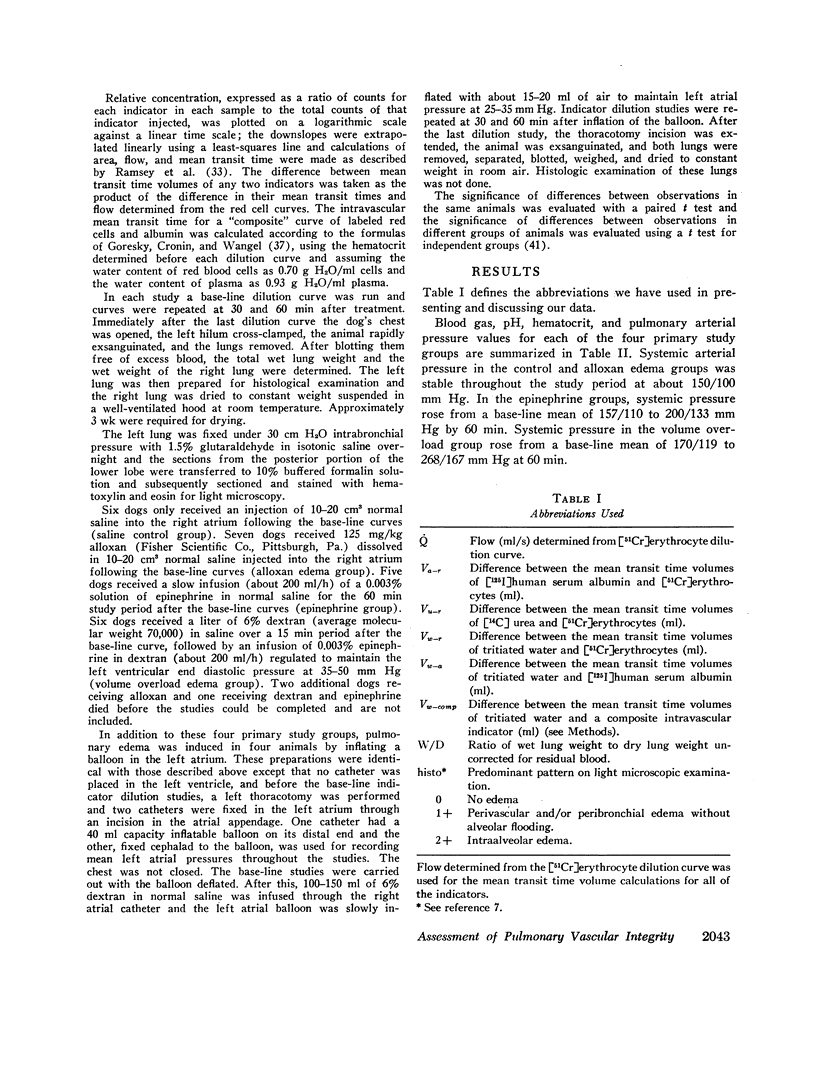
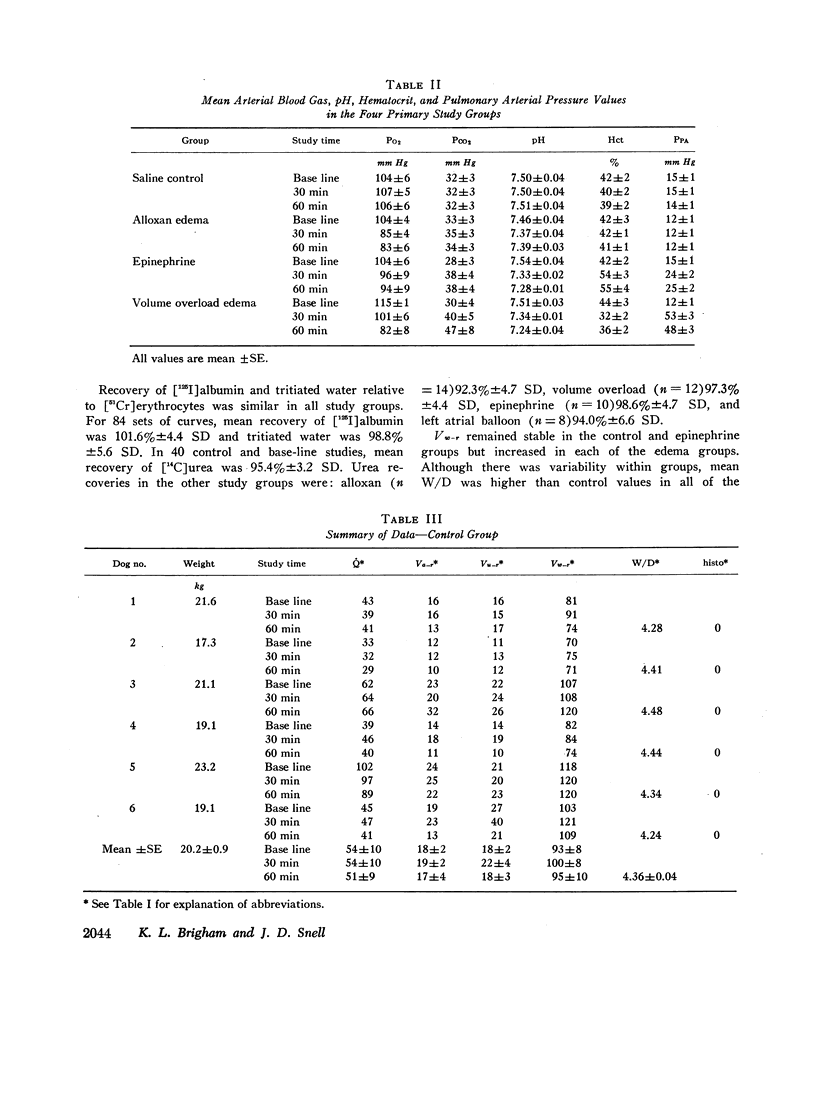
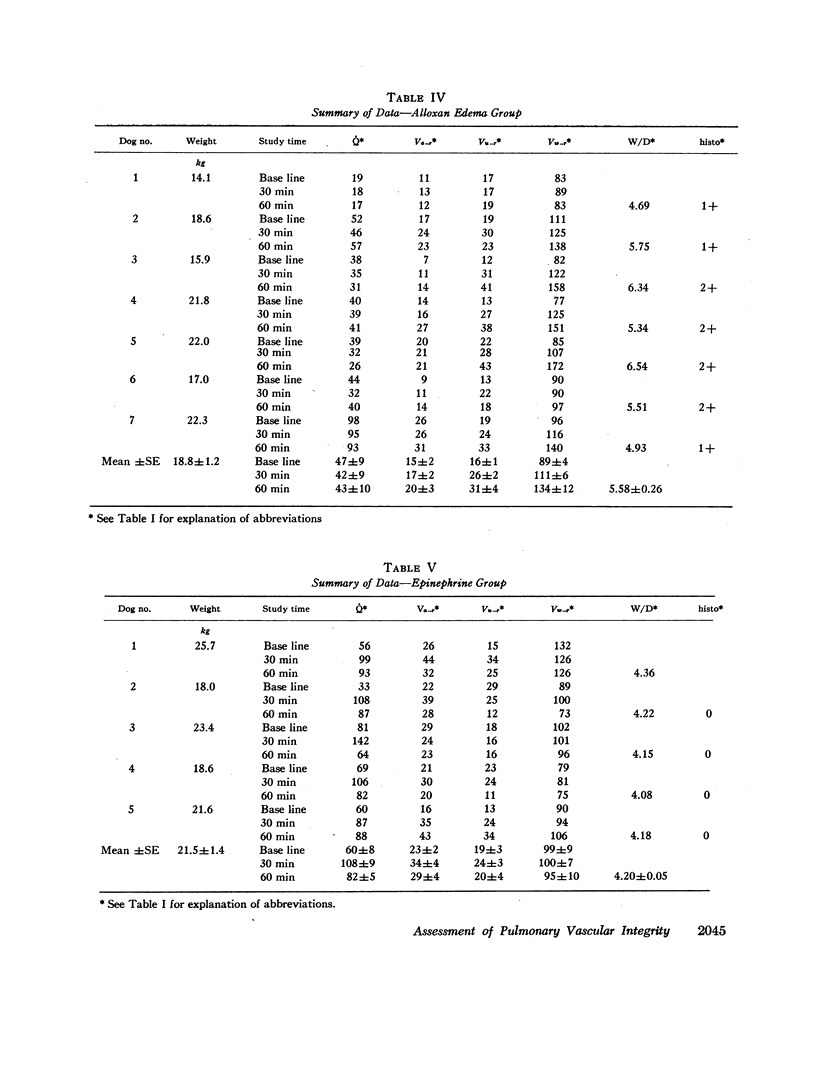
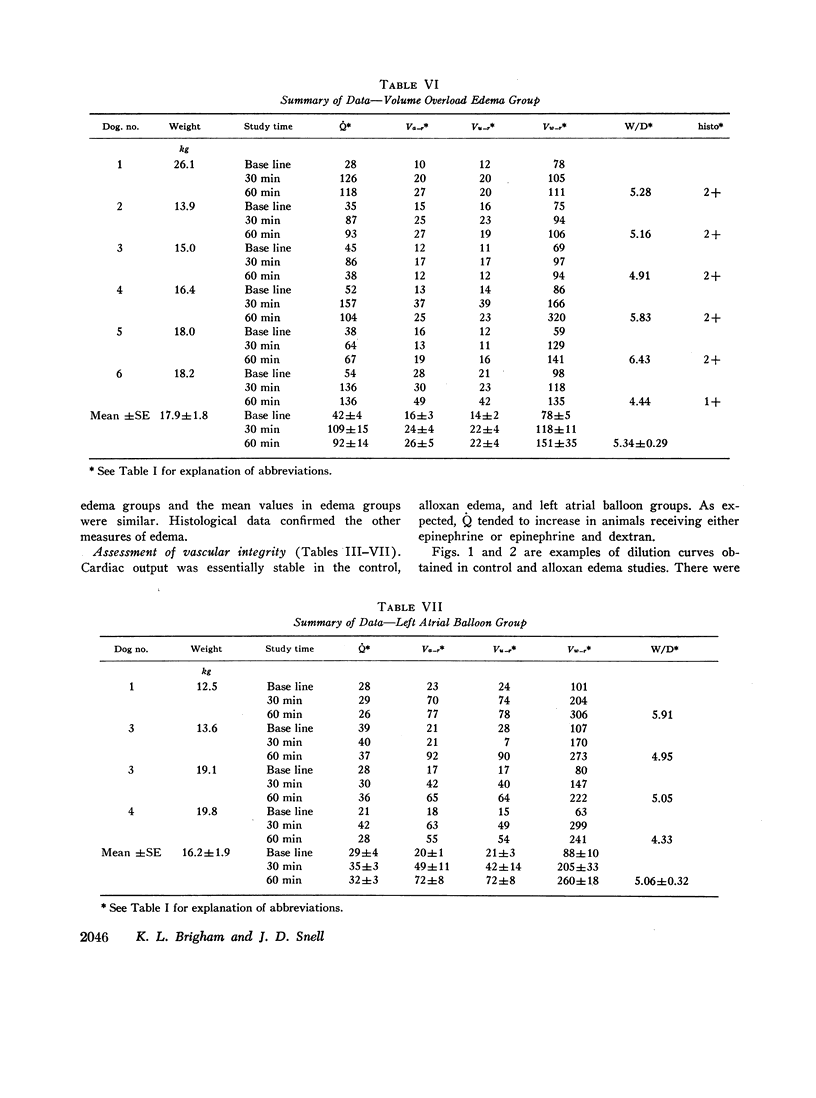
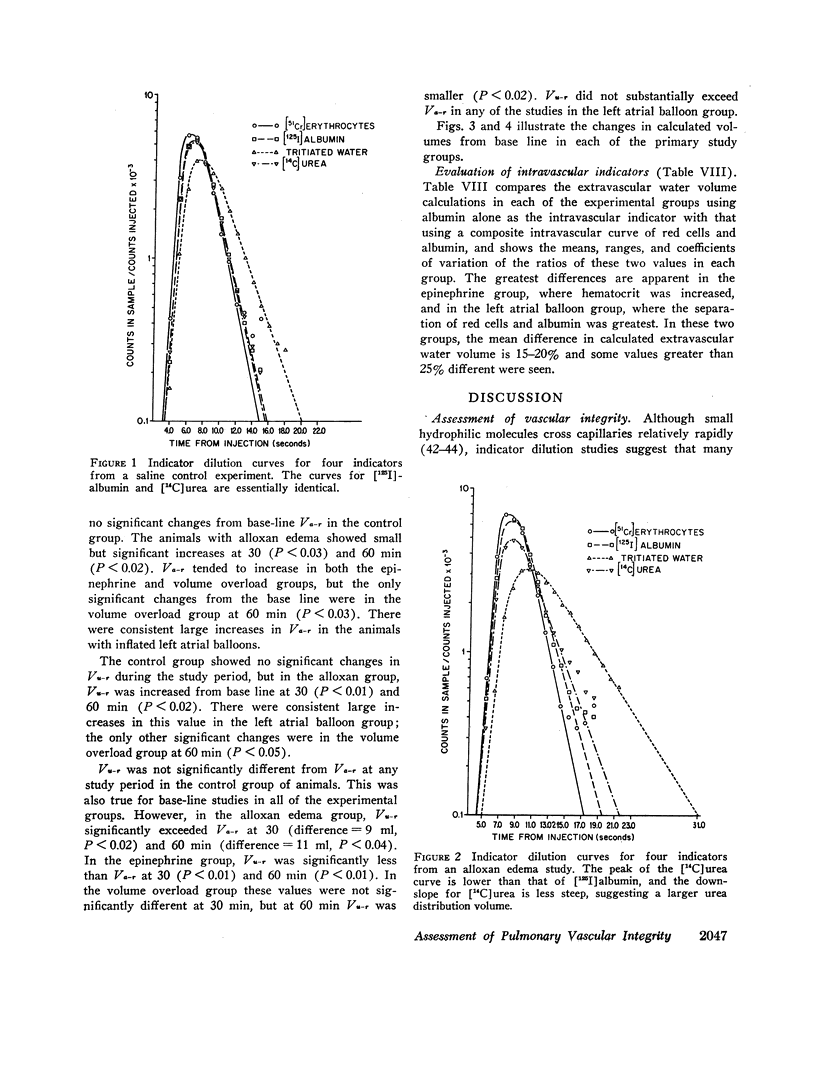
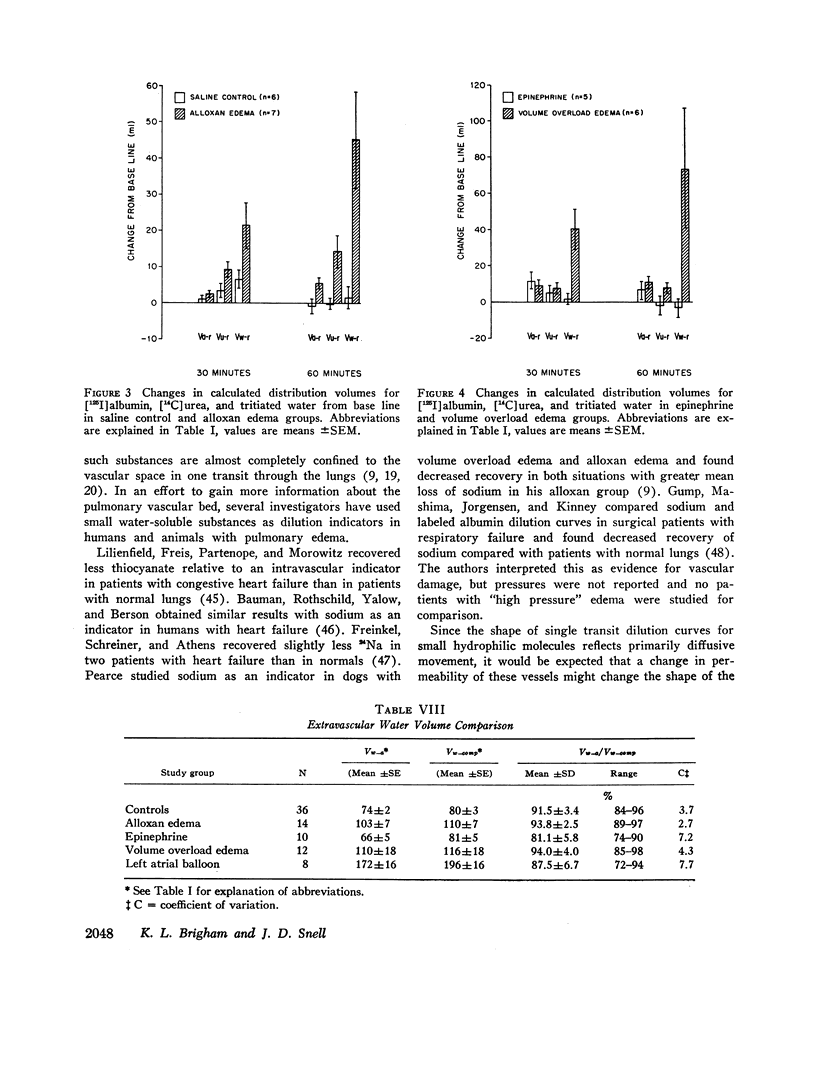
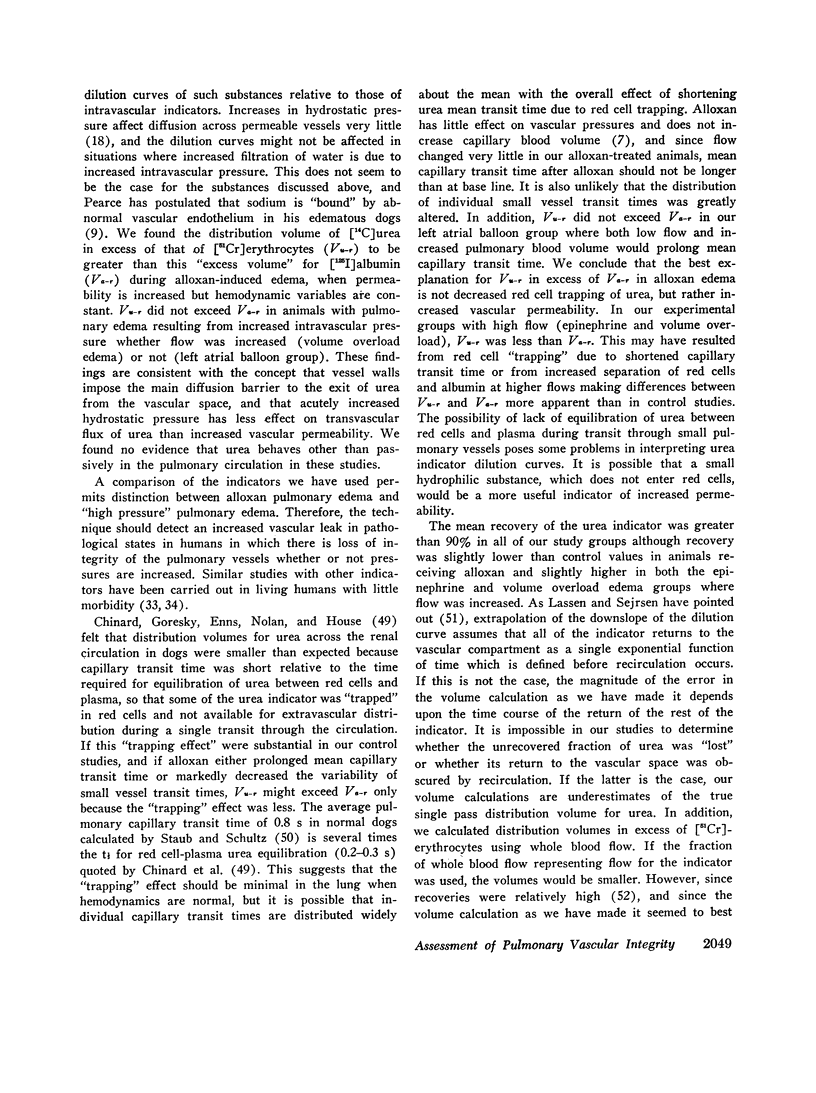
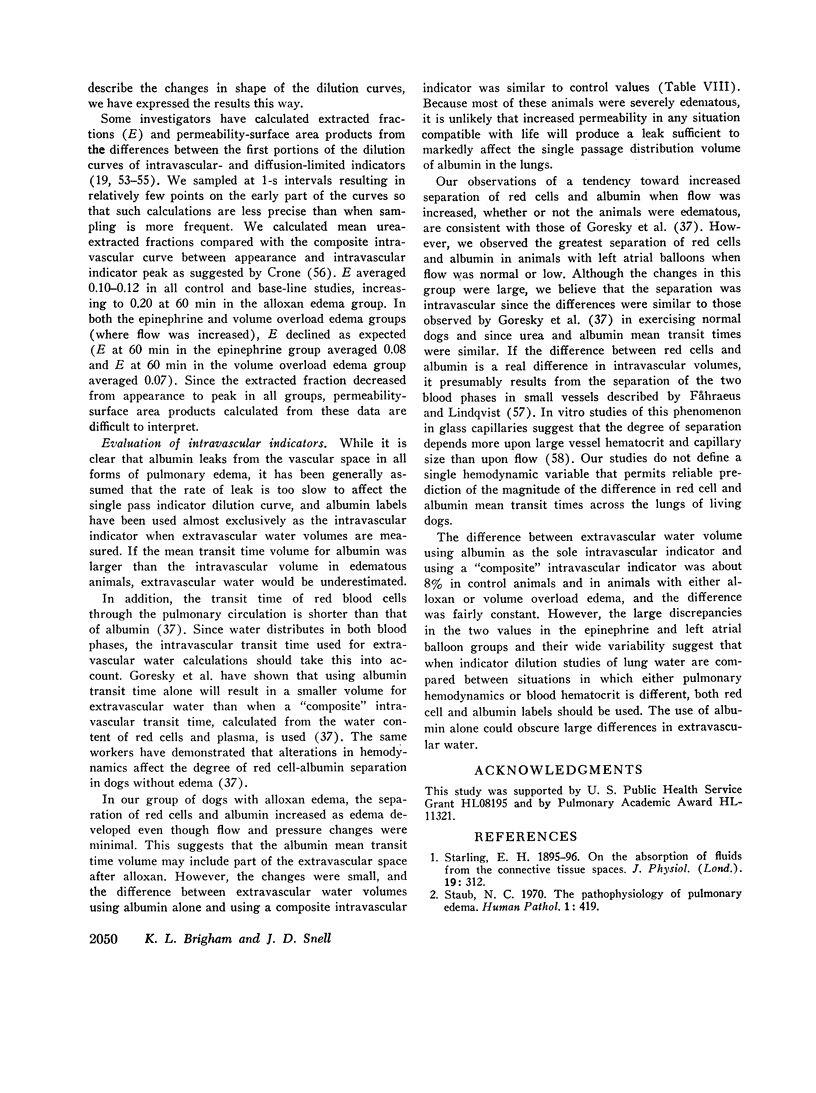
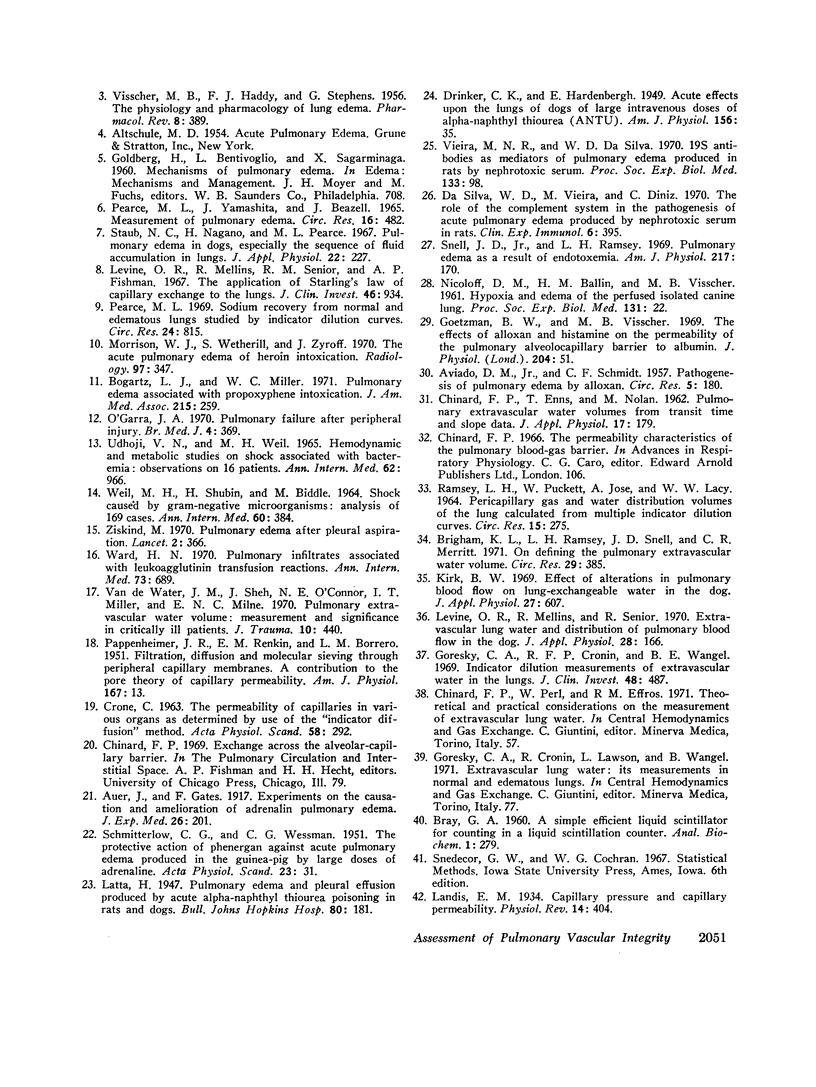
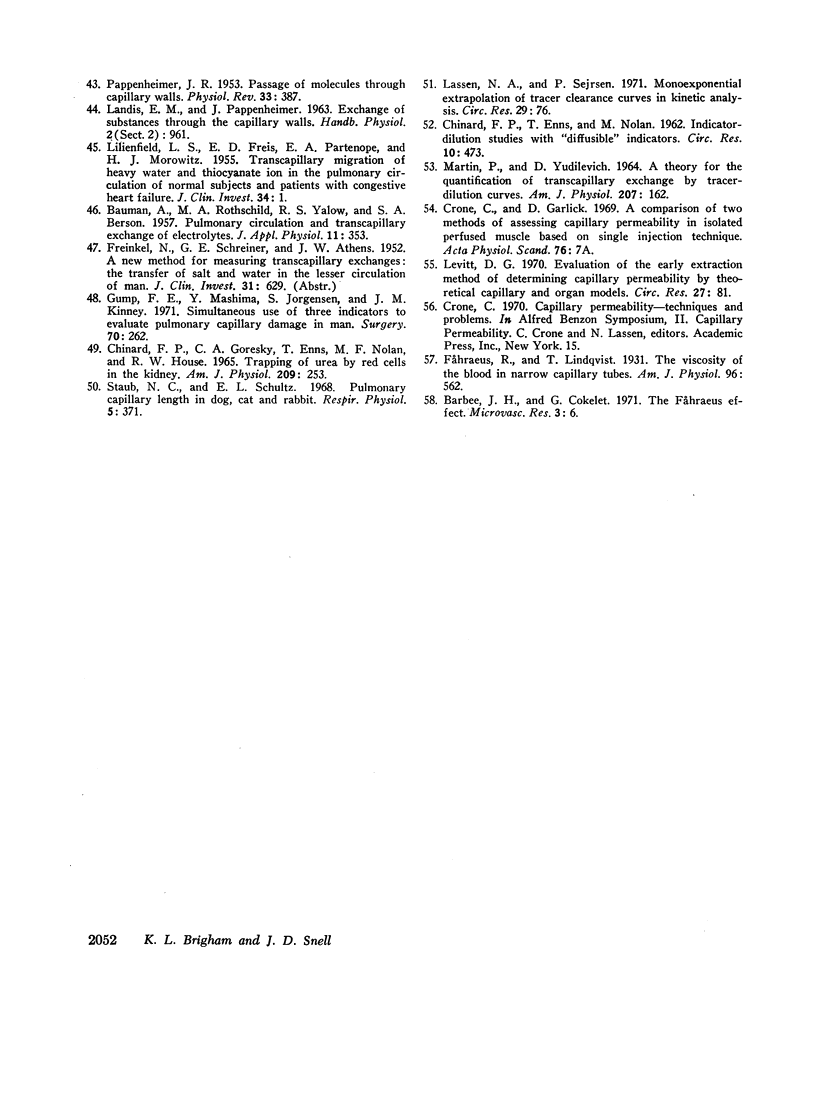
Selected References
These references are in PubMed. This may not be the complete list of references from this article.
- AVIADO D. M., Jr, SCHMIDT C. F. Pathogenesis of pulmonary edema by alloxan. Circ Res. 1957 Mar;5(2):180–186. doi: 10.1161/01.res.5.2.180. [DOI] [PubMed] [Google Scholar]
- BAUMAN A., ROTHSCHILD M. A., YALOW R. S., BERSON S. A. Pulmonary circulation and transcapillary exchange of electrolytes. J Appl Physiol. 1957 Nov;11(3):353–361. doi: 10.1152/jappl.1957.11.3.353. [DOI] [PubMed] [Google Scholar]
- Barbee J. H., Cokelet G. R. The Fahraeus effect. Microvasc Res. 1971 Jan;3(1):6–16. doi: 10.1016/0026-2862(71)90002-1. [DOI] [PubMed] [Google Scholar]
- Bogartz L. J., Miller W. C. Pulmonary edema associated with propoxyphene intoxication. JAMA. 1971 Jan 11;215(2):259–262. [PubMed] [Google Scholar]
- Brigham K. L., Ramsey L. H., Snell J. D., Merritt C. R., 3rd On defining the pulmonary extravascular water volume. Circ Res. 1971 Oct;29(4):385–397. doi: 10.1161/01.res.29.4.385. [DOI] [PubMed] [Google Scholar]
- CHINARD F. P., ENNS T., NOLAN M. F. Indicator-dilution studies with "diffusible" indicators. Circ Res. 1962 Mar;10:473–490. doi: 10.1161/01.res.10.3.473. [DOI] [PubMed] [Google Scholar]
- CHINARD F. P., GORESKY C. A., ENNS T., NOLAN M. F., HOUSE R. W. TRAPPING OF UREA BY RED CELLS IN THE KIDNEY. Am J Physiol. 1965 Aug;209:253–263. doi: 10.1152/ajplegacy.1965.209.2.253. [DOI] [PubMed] [Google Scholar]
- CRONE C. THE PERMEABILITY OF CAPILLARIES IN VARIOUS ORGANS AS DETERMINED BY USE OF THE 'INDICATOR DIFFUSION' METHOD. Acta Physiol Scand. 1963 Aug;58:292–305. doi: 10.1111/j.1748-1716.1963.tb02652.x. [DOI] [PubMed] [Google Scholar]
- Goresky C. A., Cronin R. F., Wangel B. E. Indicator dilution measurements of extravascular water in the lungs. J Clin Invest. 1969 Mar;48(3):487–501. doi: 10.1172/JCI106006. [DOI] [PMC free article] [PubMed] [Google Scholar]
- Gump F. E., Mashima Y., Jorgensen S., Kinney J. M. Simultaneous use of three indicators to evaluation pulmonary capillary damage in man. Surgery. 1971 Aug;70(2):262–270. [PubMed] [Google Scholar]
- HADDY F. J., STEPHENS G., VISSCHER M. B. The physiology and pharmacology of lung edema. Pharmacol Rev. 1956 Sep;8(3):389–434. [PubMed] [Google Scholar]
- Kirk B. W. Effect of alterations in pulmonary blood flow on lung-exchangeable water in the dog. J Appl Physiol. 1969 Nov;27(5):607–612. doi: 10.1152/jappl.1969.27.5.607. [DOI] [PubMed] [Google Scholar]
- LILIENFIELD L. S., FREIS E. D., PARTENOPE E. A., MOROWITZ H. J. Transcapillary migration of heavy water and thiocyanate ion in the pulmonary circulation of normal subjects and patients with congestive heart failure. J Clin Invest. 1955 Jan;34(1):1–8. doi: 10.1172/JCI103051. [DOI] [PMC free article] [PubMed] [Google Scholar]
- Lassen N. A., Sejrsen P. Monoexponential extrapolation of tracer clearance curves in kinetic analysis. Circ Res. 1971 Jul;29(1):76–87. doi: 10.1161/01.res.29.1.76. [DOI] [PubMed] [Google Scholar]
- Levine O. R., Mellins R. B., Senior R. M. Extravascular lung water and distribution of pulmonary blood flow in the dog. J Appl Physiol. 1970 Feb;28(2):166–171. doi: 10.1152/jappl.1970.28.2.166. [DOI] [PubMed] [Google Scholar]
- Levine O. R., Mellins R. B., Senior R. M., Fishman A. P. The application of Starling's law of capillary exchange to the lungs. J Clin Invest. 1967 Jun;46(6):934–944. doi: 10.1172/JCI105599. [DOI] [PMC free article] [PubMed] [Google Scholar]
- Levitt D. G. Evaluation of the early extraction method of determining capillary permeability by theoretical capillary and organ models. Circ Res. 1970 Jul;27(1):81–95. doi: 10.1161/01.res.27.1.81. [DOI] [PubMed] [Google Scholar]
- MARTIN P., YUDILEVICH D. A THEORY FOR THE QUANTIFICATION OF TRANSCAPILLARY EXCHANGE BY TRACER-DILUTION CURVES. Am J Physiol. 1964 Jul;207:162–168. doi: 10.1152/ajplegacy.1964.207.1.162. [DOI] [PubMed] [Google Scholar]
- Morrison W. J., Wetherill S., Zyroff J. The acute pulmonary edema of heroin intoxication. Radiology. 1970 Nov;97(2):347–351. doi: 10.1148/97.2.347. [DOI] [PubMed] [Google Scholar]
- Nicoloff D. M., Ballin H. M., Visscher M. B. Hypoxia and edema of the perfused isolated canine lung. Proc Soc Exp Biol Med. 1969 May;131(1):22–26. doi: 10.3181/00379727-131-33796. [DOI] [PubMed] [Google Scholar]
- O'Garra J. A. Pulmonary failure after peripheral injury. Br Med J. 1970 Nov 7;4(5731):369–369. doi: 10.1136/bmj.4.5731.369. [DOI] [PMC free article] [PubMed] [Google Scholar]
- PAPPENHEIMER J. R. Passage of molecules through capillary wals. Physiol Rev. 1953 Jul;33(3):387–423. doi: 10.1152/physrev.1953.33.3.387. [DOI] [PubMed] [Google Scholar]
- PAPPENHEIMER J. R., RENKIN E. M., BORRERO L. M. Filtration, diffusion and molecular sieving through peripheral capillary membranes; a contribution to the pore theory of capillary permeability. Am J Physiol. 1951 Oct;167(1):13–46. doi: 10.1152/ajplegacy.1951.167.1.13. [DOI] [PubMed] [Google Scholar]
- PEARCE M. L., YAMASHITA J., BEAZELL J. MEASUREMENT OF PULMONARY EDEMA. Circ Res. 1965 May;16:482–488. doi: 10.1161/01.res.16.5.482. [DOI] [PubMed] [Google Scholar]
- Pearce M. L. Sodium recovery from normal and edematous lungs studied by indicator dilution curves. Circ Res. 1969 Jun;24(6):815–820. doi: 10.1161/01.res.24.6.815. [DOI] [PubMed] [Google Scholar]
- RAMSEY L. H., PUCKETT W., JOSE A., LACY W. W. PERICAPILLARY GAS AND WATER DISTRIBUTION VOLUMES OF THE LUNG CALCULATED FROM MULTIPLE INDICATOR DILUTION CURVES. Circ Res. 1964 Oct;15:275–286. doi: 10.1161/01.res.15.4.275. [DOI] [PubMed] [Google Scholar]
- SCHMITERLOW C. G., WESSMAN C. G. The protective action of phenergan against acute pulmonary edema produced in the guinea-pig by large doses of adrenaline. Acta Physiol Scand. 1951 Jul 30;23(1):31–43. doi: 10.1111/j.1748-1716.1951.tb00791.x. [DOI] [PubMed] [Google Scholar]
- Snell J. D., Jr, Ramsey L. H. Pulmonary edema as a result of endotoxemia. Am J Physiol. 1969 Jul;217(1):170–175. doi: 10.1152/ajplegacy.1969.217.1.170. [DOI] [PubMed] [Google Scholar]
- Starling E. H. On the Absorption of Fluids from the Connective Tissue Spaces. J Physiol. 1896 May 5;19(4):312–326. doi: 10.1113/jphysiol.1896.sp000596. [DOI] [PMC free article] [PubMed] [Google Scholar]
- Staub N. C., Nagano H., Pearce M. L. Pulmonary edema in dogs, especially the sequence of fluid accumulation in lungs. J Appl Physiol. 1967 Feb;22(2):227–240. doi: 10.1152/jappl.1967.22.2.227. [DOI] [PubMed] [Google Scholar]
- Staub N. C., Schultz E. L. Pulmonary capillary length in dogs, cat and rabbit. Respir Physiol. 1968 Oct;5(3):371–378. doi: 10.1016/0034-5687(68)90028-5. [DOI] [PubMed] [Google Scholar]
- Staub N. C. The pathophysiology of pulmonary edema. Hum Pathol. 1970 Sep;1(3):419–432. doi: 10.1016/s0046-8177(70)80075-2. [DOI] [PubMed] [Google Scholar]
- UDHOJI V. N., WEIL M. H. HEMODYNAMIC AND METABOLIC STUDIES ON SHOCK ASSOCIATED WITH BACTEREMIA. OBSERVATIONS ON 16 PATIENTS. Ann Intern Med. 1965 May;62:966–978. doi: 10.7326/0003-4819-62-5-966. [DOI] [PubMed] [Google Scholar]
- Van de Water J. M., Sheh J. M., O'Connor N. E., Miller I. T., Milne E. N. Pulmonary extravascular water volume: measurement and significance in critically ill patients. J Trauma. 1970 Jun;10(6):440–449. [PubMed] [Google Scholar]
- WEIL M. H., SHUBIN H., BIDDLE M. SHOCK CAUSED BY GRAM-NEGATIVE MICROORGANISMS. ANALYSIS OF 169 CASES. Ann Intern Med. 1964 Mar;60:384–400. doi: 10.7326/0003-4819-60-3-384. [DOI] [PubMed] [Google Scholar]
- Ward H. N. Pulmonary infiltrates associated with leukoagglutinin transfusion reactions. Ann Intern Med. 1970 Nov;73(5):689–694. doi: 10.7326/0003-4819-73-5-689. [DOI] [PubMed] [Google Scholar]
- Ziskind M. Pulmonary oedema after pleural aspiration. Lancet. 1970 Aug 15;2(7668):366–366. doi: 10.1016/s0140-6736(70)92901-6. [DOI] [PubMed] [Google Scholar]
- da Silva W. D., Vieira M. N., Diniz C. R. The role of the complement system in the pathogenesis of acute pulmonary oedema produced by nephrotoxic serum in rats. Clin Exp Immunol. 1970 Mar;6(3):395–406. [PMC free article] [PubMed] [Google Scholar]


